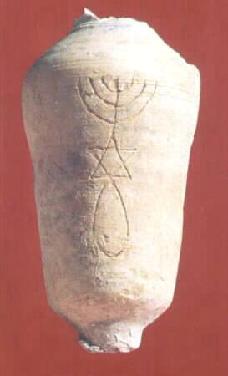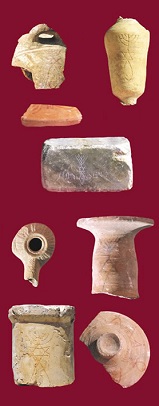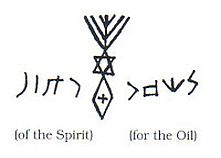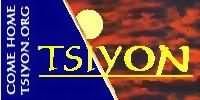|
Aurora, Colo. (EP) — A Messianic Seal from the Christian church in ancient
Jerusalem has been rediscovered after 2000 years. This ancient symbol was
found on Mount Zion. It is believed to have been created and used by the
Jewish believers who called themselves Nazarenes in the first Messianic
Church.
Three companies—Olim Creative Products of Tiberias, News About Israel (NAI)
of Jerusalem, and Christian Floral Delivery of Colorado—jointly announced
the discovery of this ancient symbol, which has been copyrighted by NAI. It
consists of three separate but integrated symbols: a menorah at the top, a
star of David in the middle, and a fish at the bottom. In each of the
renditions of the three-part symbol the star is created by interlacing the
stand of the menorah with the fish.
The Messianic Seal was found etched or inscribed on eight ancient artifacts.
The artifacts were presented to Ludwig Schneider, editor in chief of NAI's
magazine, Israel Today, in 1990. They came from Tech Otecus, an elderly monk
who lived as a hermit in the Old City of Jerusalem. Otecus said that in the
1960s he had personally excavated about 40 artifacts bearing the Messianic
Seal from an ancient grotto located in the immediate vicinity of the Upper
Room on Mount Zion.
What was once the main entrance to the grotto is now covered with a
jail-like heavy wire mesh enclosure. Its door, leading down into the ancient
baptismal place, is tightly secured with a heavy chain and lock. According
to Schneider, the last remaining entry to the grotto was sealed shortly
after he excitedly told the priests at the local monastery about the
discovery of the Messianic Seal.
Schneider photographed eight artifacts which were given to him by Otecus,
and showed the pictures to the curator of the Israel Museum. "When he had
carefully studied my pictures," Schneider recalled, "the curator immediately
promised me that these artifacts and their unique symbol were an important
find. He told me that the museum had seen other artifacts bearing the same
three-part symbol from some other sources he did not specify."
According to Bob Fischer, president of Olim Creative Products and co-author
with local historian and artist Reuven Schmalz of their book, The
Messianic Seal of the Jerusalem Church, the ancient three-part symbol
has, since 135 A.D., been suppressed by various Israeli groups or agencies,
such as the Israel Museum and Orthodox rabbis in the Old City of Jerusalem,
while simultaneously being buried for these nearly two millennia by the
church.
According to Fischer, at least two of the eight artifacts were obviously
ceremonial pieces which may have well been used by James the Just, the
brother of Jesus, who is said to be the first pastor of the church, or
perhaps even by one or more of the Twelve Apostles.
 One
of the eight artifacts is a brick-sized block of well-worn local marble.
This piece bears an etched version of the Messianic Seal with a Taw (the
last letter in the ancient Hebrew alphabet that looks exactly like a sign of
the cross) in the eye of the fish symbol, as well as the ancient Aramaic
lettering proclaiming the use of this artifact as a stand to hold a vial of
anointing oil. The ancient Aramaic is transliterated as, "La Shemen Ruehon"
(For the Oil of the Spirit). Another of the eight artifacts is a small,
almost intact, vial which could well have sat on top of the marble stand. One
of the eight artifacts is a brick-sized block of well-worn local marble.
This piece bears an etched version of the Messianic Seal with a Taw (the
last letter in the ancient Hebrew alphabet that looks exactly like a sign of
the cross) in the eye of the fish symbol, as well as the ancient Aramaic
lettering proclaiming the use of this artifact as a stand to hold a vial of
anointing oil. The ancient Aramaic is transliterated as, "La Shemen Ruehon"
(For the Oil of the Spirit). Another of the eight artifacts is a small,
almost intact, vial which could well have sat on top of the marble stand.
 Commenting
on what he characterized as the "monumental importance" of this
archaeological discovery, Fischer said, "Beyond the historical background of
the Nazarenes, the first Jewish believers who founded the Jerusalem Church,
the Messianic Seal itself proclaims to the world the pervasive Jewishness of
Jesus Christ and the decidedly Jewish foundation and roots of the church
founded in His name." Commenting
on what he characterized as the "monumental importance" of this
archaeological discovery, Fischer said, "Beyond the historical background of
the Nazarenes, the first Jewish believers who founded the Jerusalem Church,
the Messianic Seal itself proclaims to the world the pervasive Jewishness of
Jesus Christ and the decidedly Jewish foundation and roots of the church
founded in His name."
"The Messianic Seal of the Jerusalem Church," Fischer continued, "strikes at
the very roots of anti-Semitism while proclaiming a compelling message that
restores unity: Jew with Jew, and Jew with Gentile. The importance of this
discovery cannot be minimized. The Messianic Seal is not only just the key
to understanding the Dead Sea Scrolls, it can and should shake the
foundations of the church and orthodox Judaism with its incredible message
of unity and love. It breaks down barriers that have existed for millennia
and points the way toward restoration."
—Evangelical Press News Service, July 6, 1999
The Most Ancient
Symbol of Christianity
“For the Oil of the Spirit”
FOUND: The First Century
baptismal grotto of James the Just and the Apostles on Mount Zion,
Jerusalem. James, the brother of Jesus, was the leader of the first Nazarene
(Messianic) church located in the Upper Room on Mount Zion.
Our story begins in 1963, when a small ceremonial silver lamina (a thin
plate) was found in the Judean Desert near Jerusalem, dating back to the
first Century. A Catholic priest and archaeologist named Emanuel Testa
deciphered the Aramaic text of this artifact, the first line of which reads:
“For the Oil of the Spirit.” Testa was amazed to find that the text was
nearly identical to James 5:14-16. This tiny lamina (3"x1") is a sort of
pass card or certificate of belief in Jesus, used in early Jewish-Christian
baptism to confirm the forgiveness of sins and “right of passage” into the
Kingdom of Heaven.
This text from the Book of James clearly indicates that the earliest Jewish
Christians anointed believers with oil. What has not been clearly understood
until now is how this anointing was connected with baptism and the entry
into the faith. This is no longer a mystery.
|

|

|
|
Detail of
inscription on the face of the oil stand. (at right above) |
 |
|
Pictures from Schmalz,
Reuven Efraim et al, The Messianic Seal of the Jerusalem Church,
Olim Publications, Tiberias, Israel, 1999 |
In
1990, Ludwig Schneider, editor in chief of the magazine Israel Update,
struck up a friendship with an old Greek Orthodox monk who lived as a hermit
in the Old City of Jerusalem. On one occasion, the monk showed Schneider a
cache of artifacts that he had secretly excavated on Mount Zion before the
Six Day War in 1967. Scheneider was taken aback. Many of these pottery
shards, oil lamps and stone pieces were engraved with an unknown symbol. The
symbol consisted of a menorah on top, a Star of David in the centre and a
fish at the bottom. Schneider was immediately convinced that this must have
been a symbol of the first Jewish-Christian church (assembly).
The
monk then led Schneider to a cavity in the rock adjacent to the Tomb of
David and the Upper Room on Mount Zion, and told him that this is where he
found the artifacts. Today, the cave is dark and musty and sealed off with
iron bars. As legend has it, some great secrets are hidden there. Some say
that according to the Dead Sea Scrolls, it is a cache of Second Temple
treasures. The most popular legend is that deep within this cave lies the
long lost Ark of the Covenant.
As it
turns out, this is the sacred baptismal grotto of the first Nazarene
(Messianic) church, and the treasure hidden there was the First and Second
Century artifacts (about 60 in all) found by the monk. Among these artifacts
is a brick-shaped piece of local marble inscribed with the Messianic Seal
and the words in ancient Aramaic: “For the Oil of the Spirit.” This seems to
have been the base for a vial of anointing oil. A small pottery flask with a
Messianic Seal found nearby supports this theory.
In my
opinion, this piece of marble came into use in the earliest Nazarene times
at this baptismal site, below the church in the Upper Room established by
James the Just and the Apostles. This was, of course, a perfect place for
the first church, because the Upper Room is where the Holy Spirit fell upon
the disciples at Pentecost. The church was located in the heart of the
Essene (a strict, contemplative Jewish sect) Quarter, and was probably a
Qumran-like Essene community. According to the Book of Acts, there was
strict discipline and a hierarchy. It stands to reason that this group would
have immediately established Nazarene ritual, including a ceremonial healing
and baptismal centre where conversions were sealed by immersion in water and
anointing with oil. Judging from the inscription “For the Oil of the
Spirit,” the anointing was symbolic of baptism in the Holy Spirit. The Book
of Acts records 3,000 conversions here on the day of Pentecost alone.
I
believe that James and the Apostles administered the “Oil of the Spirit”
from this very stone base. That would make this piece, if my suspicions are
correct, the earliest known Christian artifact. I believe that the
previously discovered lamina with the same inscription was also used in this
congregation.
But ten
years after its discovery, this historic, amazing find remains a well-kept
secret. Ludwig Schneider approached the Israel Museum with the artifacts,
and was promised that they would be put on display. But it never happened.
It seems that the Israeli authorities do not want the mystery of the
Messianic Seal to come to light.
By
Reuven E. Schmalz
Note: The News articles above have been published widely at multiple sites
on the internet. We repeat them here for your convenience. - Tsiyon.org |

 One
of the eight artifacts is a brick-sized block of well-worn local marble.
This piece bears an etched version of the Messianic Seal with a Taw (the
last letter in the ancient Hebrew alphabet that looks exactly like a sign of
the cross) in the eye of the fish symbol, as well as the ancient Aramaic
lettering proclaiming the use of this artifact as a stand to hold a vial of
anointing oil. The ancient Aramaic is transliterated as, "La Shemen Ruehon"
(For the Oil of the Spirit). Another of the eight artifacts is a small,
almost intact, vial which could well have sat on top of the marble stand.
One
of the eight artifacts is a brick-sized block of well-worn local marble.
This piece bears an etched version of the Messianic Seal with a Taw (the
last letter in the ancient Hebrew alphabet that looks exactly like a sign of
the cross) in the eye of the fish symbol, as well as the ancient Aramaic
lettering proclaiming the use of this artifact as a stand to hold a vial of
anointing oil. The ancient Aramaic is transliterated as, "La Shemen Ruehon"
(For the Oil of the Spirit). Another of the eight artifacts is a small,
almost intact, vial which could well have sat on top of the marble stand. Commenting
on what he characterized as the "monumental importance" of this
archaeological discovery, Fischer said, "Beyond the historical background of
the Nazarenes, the first Jewish believers who founded the Jerusalem Church,
the Messianic Seal itself proclaims to the world the pervasive Jewishness of
Jesus Christ and the decidedly Jewish foundation and roots of the church
founded in His name."
Commenting
on what he characterized as the "monumental importance" of this
archaeological discovery, Fischer said, "Beyond the historical background of
the Nazarenes, the first Jewish believers who founded the Jerusalem Church,
the Messianic Seal itself proclaims to the world the pervasive Jewishness of
Jesus Christ and the decidedly Jewish foundation and roots of the church
founded in His name."

